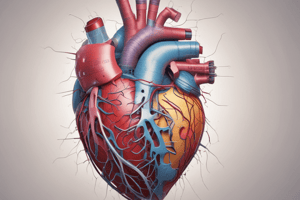Podcast
Questions and Answers
What is a common procedure performed in cardiac surgery?
What is a common procedure performed in cardiac surgery?
- Mediastinal tumor resection
- Esophagectomy
- Coronary artery bypass grafting (CABG) (correct)
- Lobectomy
Which of the following is NOT an indication for thoracic surgery?
Which of the following is NOT an indication for thoracic surgery?
- Lung cancer
- Mediastinal masses
- Congenital heart defects (correct)
- Chest trauma
What are major categories of cardiovascular diseases?
What are major categories of cardiovascular diseases?
- Hypertension and diabetes
- Coronary artery disease and heart failure (correct)
- Lung cancer and arrhythmias
- Valvular heart diseases and asthma
Which surgical technique is characterized by requiring smaller incisions and less trauma?
Which surgical technique is characterized by requiring smaller incisions and less trauma?
Which of these risk factors is commonly associated with cardiovascular diseases?
Which of these risk factors is commonly associated with cardiovascular diseases?
What constitutes the primary focus of intraoperative patient management?
What constitutes the primary focus of intraoperative patient management?
Which procedure involves the resection of lung tissue?
Which procedure involves the resection of lung tissue?
What is often considered in the long-term management of patients after cardiac surgery?
What is often considered in the long-term management of patients after cardiac surgery?
Flashcards are hidden until you start studying
Study Notes
Cardiothoracic
Cardiac Surgery
- Involves surgical procedures on the heart and great vessels.
- Common procedures:
- Coronary artery bypass grafting (CABG)
- Valve repair or replacement (e.g., aortic, mitral)
- Aneurysm repair
- Heart transplantation
- Indications include ischemic heart disease, valvular heart disease, and congenital heart defects.
Thoracic Surgery
- Focuses on surgical interventions in the thoracic cavity, excluding the heart.
- Common procedures:
- Lobectomy or pneumonectomy for lung cancer
- Thoracoscopic surgery (VATS)
- Esophagectomy for esophageal cancer
- Mediastinal tumor resection
- Indications include lung diseases, mediastinal masses, and chest trauma.
Cardiovascular Diseases
- Encompass a range of disorders affecting the heart and blood vessels.
- Major categories:
- Coronary artery disease (CAD)
- Heart failure
- Arrhythmias
- Valvular heart diseases
- Risk factors include hypertension, diabetes, smoking, and high cholesterol.
Surgical Techniques
- Open-heart surgery: Traditional approach requiring sternotomy.
- Minimally invasive cardiac surgery (MICS): Smaller incisions, less trauma.
- Robotic-assisted surgery: Enhanced precision and control.
- Video-assisted thoracoscopic surgery (VATS): Minimally invasive approach for thoracic procedures.
- Hybrid procedures: Combine surgical and interventional techniques.
Patient Management
- Preoperative care: Comprehensive assessment, imaging studies, and optimization of comorbid conditions.
- Intraoperative considerations: Anesthesia management, monitoring, and surgical team coordination.
- Postoperative care: Pain management, monitoring for complications (e.g., infection, bleeding), and rehabilitation.
- Long-term management: Lifestyle modifications, medication adherence, and regular follow-ups.
Cardiac Surgery
- Surgical procedures target the heart and major blood vessels.
- Common procedures include:
- Coronary Artery Bypass Grafting (CABG): Restores blood flow to heart muscle.
- Valve Repair/Replacement: Addresses dysfunction in valves such as aortic and mitral valves.
- Aneurysm Repair: Corrects abnormal dilations in blood vessels.
- Heart Transplantation: Replaces diseased heart with a donor heart.
- Common conditions treated: ischemic heart disease, valvular heart disease, congenital heart defects.
Thoracic Surgery
- Focuses on procedures in the thoracic cavity, excluding the heart.
- Common procedures include:
- Lobectomy or Pneumonectomy: Surgical removal of lung tissue due to cancer.
- Thoracoscopic Surgery (VATS): Minimally invasive approach using small incisions.
- Esophagectomy: Removal of all or part of the esophagus often due to cancer.
- Mediastinal Tumor Resection: Removal of tumors located in the mediastinum.
- Indications: lung diseases, mediastinal masses, chest trauma.
Cardiovascular Diseases
- A broad spectrum of disorders impacting the heart and blood vessels.
- Major categories include:
- Coronary Artery Disease (CAD): Hardening and narrowing of coronary arteries.
- Heart Failure: Inability of the heart to pump effectively.
- Arrhythmias: Abnormal heart rhythms.
- Valvular Heart Diseases: Disorders affecting any of the heart valves.
- Key risk factors: hypertension, diabetes, smoking, high cholesterol levels.
Surgical Techniques
- Open-Heart Surgery: Traditional method requiring sternotomy to access the heart.
- Minimally Invasive Cardiac Surgery (MICS): Employs smaller incisions, resulting in less trauma and quicker recovery.
- Robotic-Assisted Surgery: Offers enhanced precision and control through robotic systems.
- Video-Assisted Thoracoscopic Surgery (VATS): A minimally invasive technique for thoracic interventions.
- Hybrid Procedures: Combine surgical and interventional techniques for complex cases.
Patient Management
- Preoperative Care: Involves detailed patient assessment, imaging, and managing comorbid conditions.
- Intraoperative Considerations: Includes managing anesthesia and monitoring patient status during surgery.
- Postoperative Care: Focuses on pain management and monitoring for complications, such as infections and bleeding.
- Long-Term Management: Emphasizes lifestyle changes, adherence to medication, and regular check-ups for ongoing health monitoring.
Studying That Suits You
Use AI to generate personalized quizzes and flashcards to suit your learning preferences.




